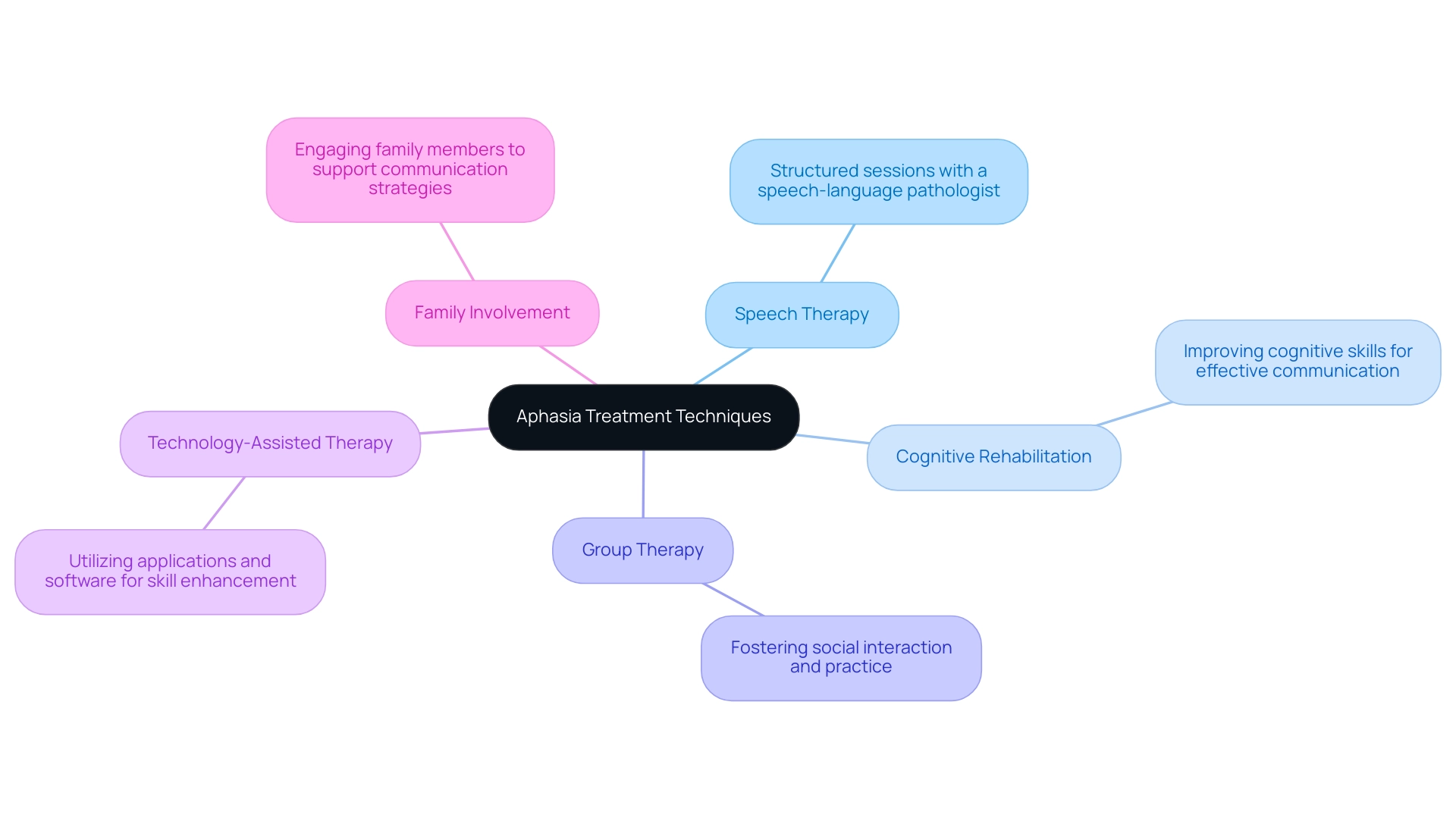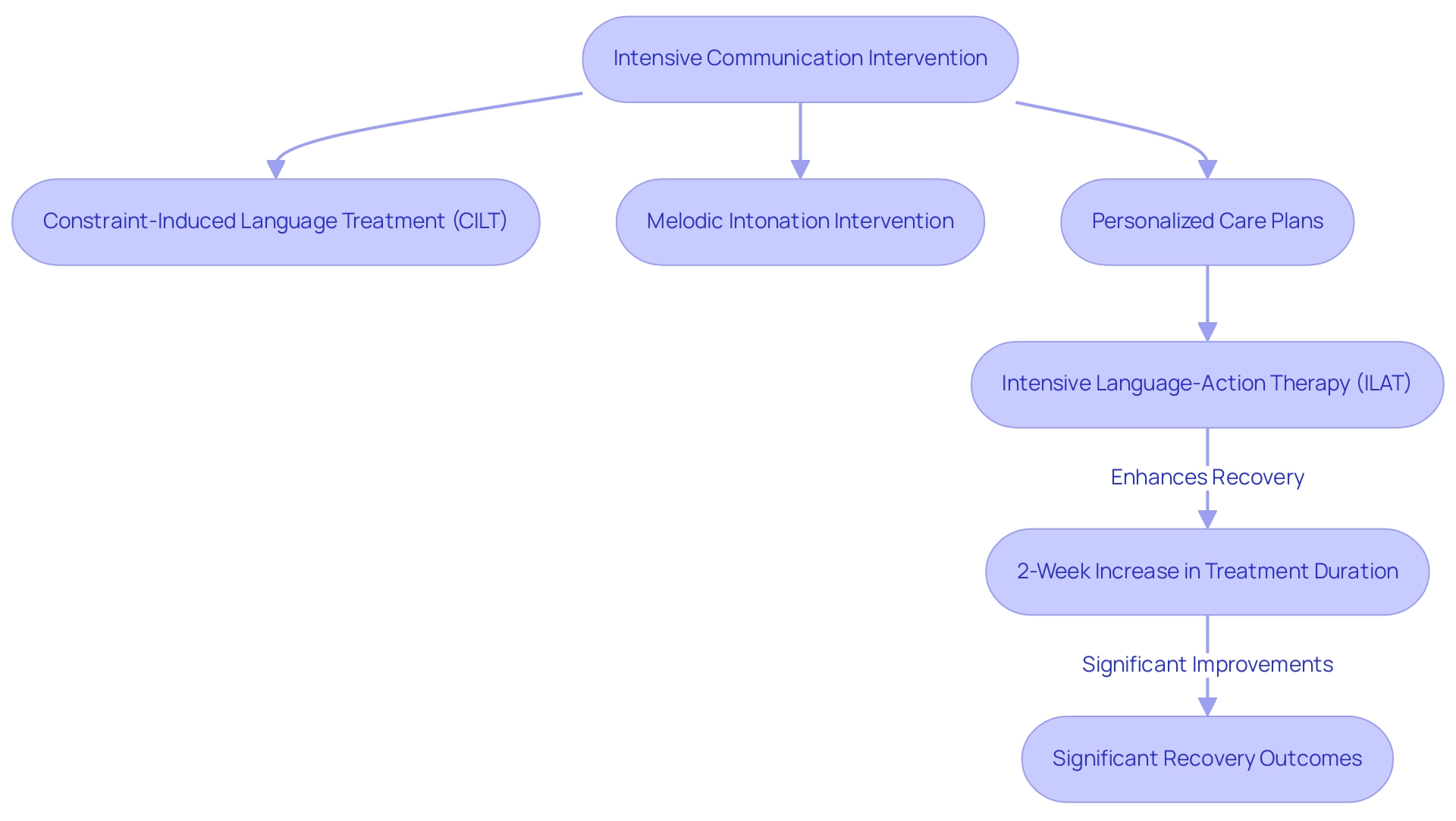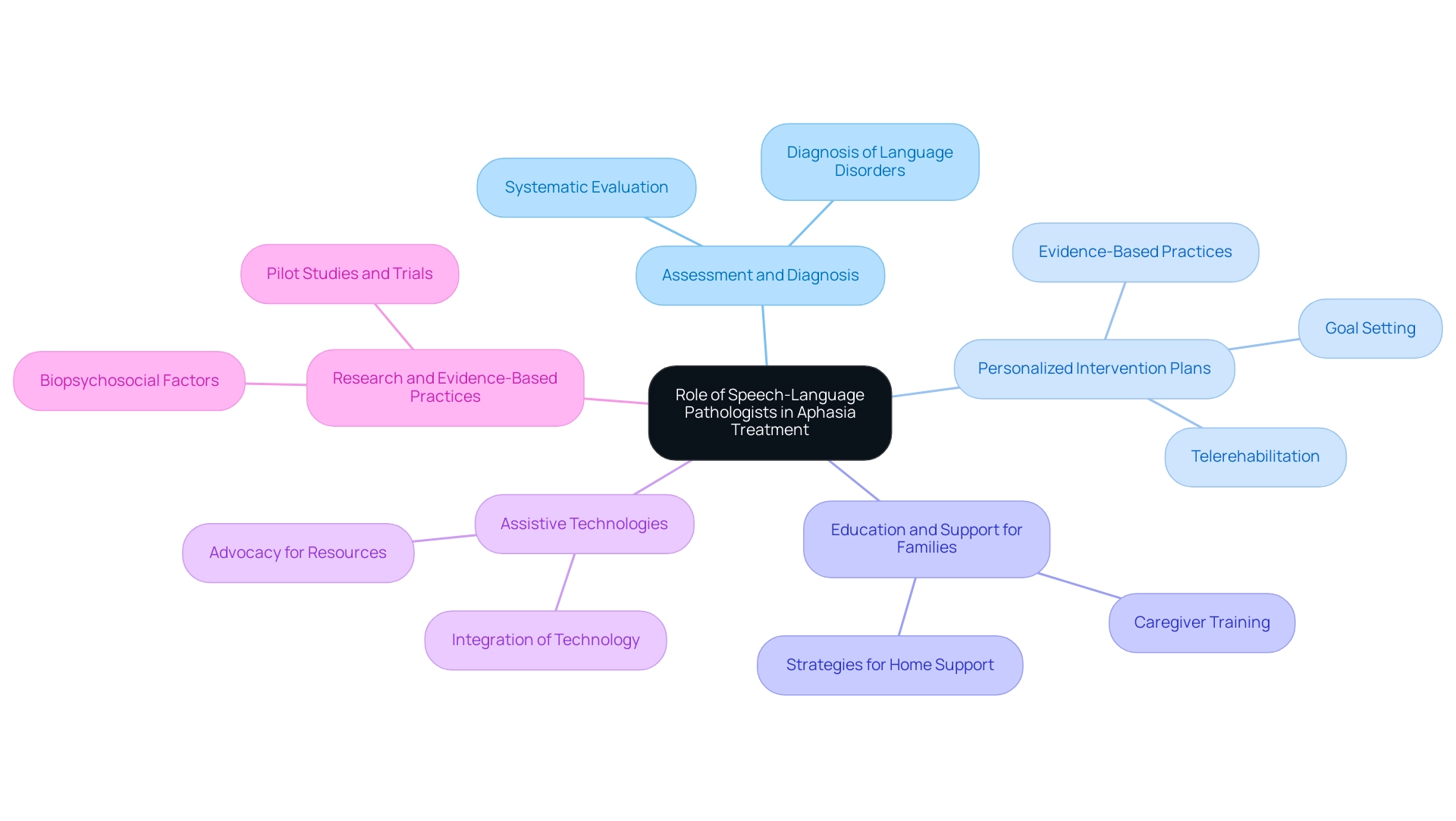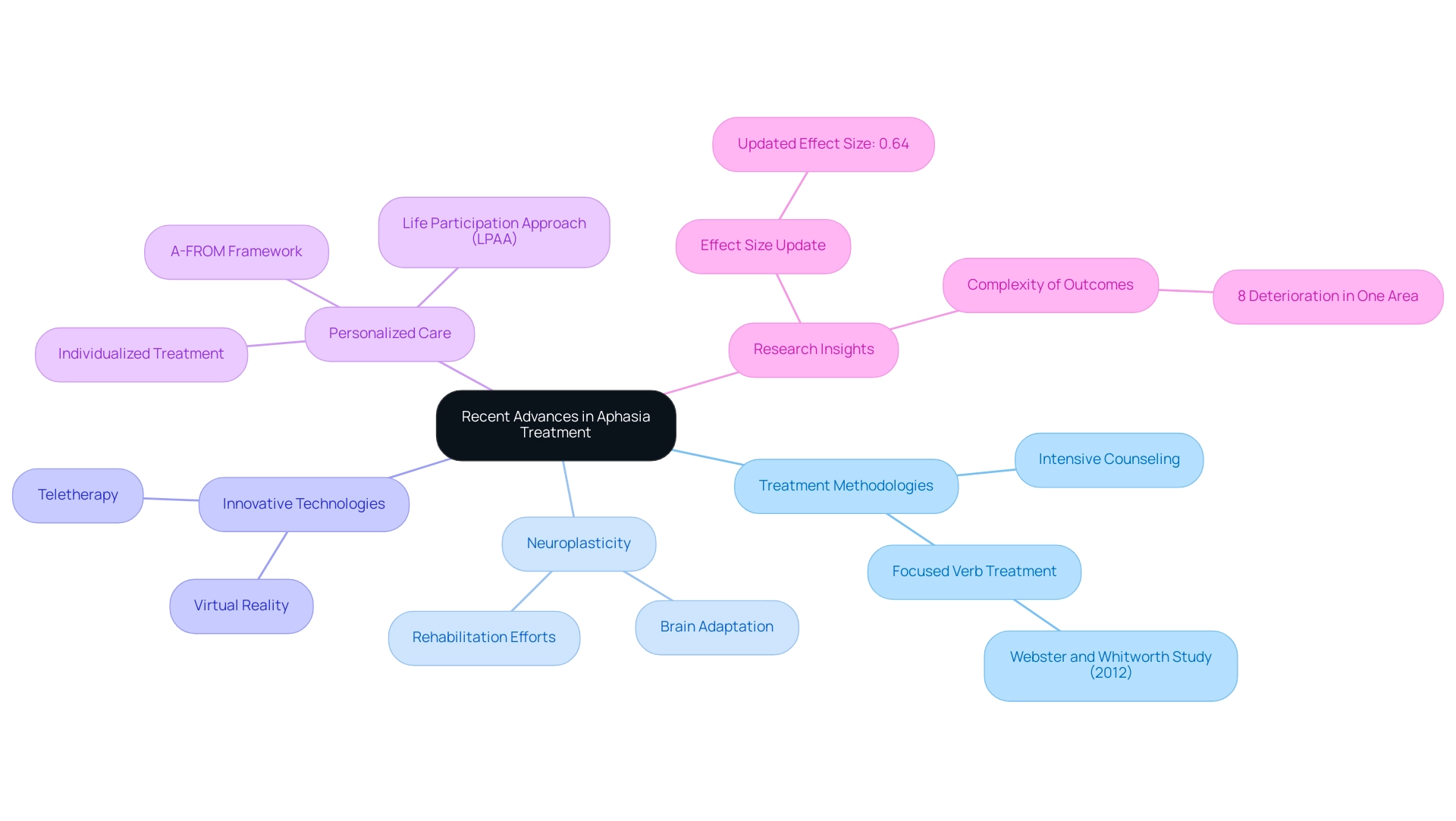Introduction
Aphasia, a language disorder affecting millions, presents significant challenges in communication for those impacted. As the understanding of this condition evolves, so too do the treatment strategies aimed at fostering recovery. This article delves into a comprehensive overview of various aphasia treatment techniques, emphasizing the importance of personalized approaches that cater to individual needs.
From traditional speech therapy to innovative technology-assisted methods, the landscape of aphasia treatment is rapidly changing. By exploring intensive therapy modalities and the critical role of speech-language pathologists, this discussion highlights the multifaceted nature of effective rehabilitation.
Furthermore, it underscores the necessity for thorough assessment and the incorporation of recent research findings to enhance therapeutic outcomes, paving the way for improved communication abilities in those affected by aphasia.
1. Overview of Aphasia Treatment Techniques
Aphasia treatment consists of a diverse array of techniques designed to enhance communication abilities among individuals affected by this condition, which impacts approximately 2,000,000 people in the USA and 250,000 in Great Britain. Key approaches include:
-
Speech Therapy: This method involves structured sessions with a speech-language pathologist (SLP) aimed at developing specific communication skills through targeted exercises and techniques.
-
Cognitive Rehabilitation: This approach is centered on improving cognitive skills essential for effective communication, such as memory, attention, and problem-solving abilities.
-
Group Therapy: This modality fosters social interaction among participants, allowing practice of communication strategies in a supportive group environment.
-
Technology-Assisted Therapy: Utilizing modern technology, this technique incorporates various applications and software specifically designed to facilitate skill enhancement.
-
Family Involvement: Engaging family members in the therapy process is crucial, as it supports the reinforcement of communication strategies in everyday settings and encourages a collaborative approach to recovery.
These methods are continuously evolving, and the recent findings also highlight significant variability of effect sizes across language disorders, particularly in 'Written language', which underscores the necessity for customized strategies in aphasia treatment that address individual patient needs. Insights from a case study involving a total of
1713 treatment cycles applied to individuals with language impairment (PWA) reveal a significant number of treatment cycles and provide a comprehensive overview of the patient population across early subacute, late subacute, and chronic phases of the condition. As the field advances, the inclusion of various methods and family involvement remains crucial in attaining favorable cognitive rehabilitation results for individuals with communication disorders.
2. Intensive and Multimodal Approaches to Aphasia Therapy
Intensive communication intervention, an important form of aphasia treatment, is characterized by its concentrated sessions that often take place several times a week, aiming to directly target specific speech deficits. This therapeutic approach is often complemented by multimodal strategies that utilize diverse communication forms—such as gestures, writing, and technology—to enhance both understanding and expression. Notable techniques within this framework include:
- Constraint-Induced Language Treatment (CILT), which is an effective aphasia treatment that promotes the use of spoken language by limiting alternative communication methods.
- Melodic intonation intervention, which utilizes musical elements to facilitate speech production.
Recent studies indicate substantial responder rates for intensive therapy protocols, as highlighted by Cornelius J. Werner, who stated,
Intensive therapy protocols for language disorders after stroke are yielding substantial responder rates in a routine clinical setting including a wide range of patients.
Furthermore, research emphasizes the importance of personalized care plans customized to individual challenges. A recent study on Intensive Language-Action Therapy (ILAT) demonstrated that a small increase of just two weeks in duration can significantly enhance recovery outcomes for individuals with chronic post-stroke aphasia treatment.
Specifically, the study involved thirty individuals and found that while significant communication performance improvements occurred after each training interval, extending the duration by two weeks was particularly beneficial, suggesting that lower daily practice is sufficient for effective intervention. Furthermore, the effectiveness of intensive treatment is supported by a syntactic structure raw score of 9.44 and an effect size of 0.20, indicating significant enhancements in communication processing capabilities. Overall, these advancements in intensive and multimodal strategies indicate a promising path in aphasia treatment and communication disorder rehabilitation, fostering enhanced verbal performance and recovery.
3. The Role of Speech-Language Pathologists in Aphasia Treatment
Speech-language pathologists (SLPs) act as crucial figures in the
assessment, diagnosis, and management of language disorders, utilizing a systematic method to evaluate language deficits and create customized intervention plans. Significantly, the likelihood of being a prompt treatment responder diminishes with extended duration of language impairment, highlighting the necessity of timely intervention. Utilizing evidence-based practices, SLPs ensure that interventions are grounded in the latest research, enhancing the efficacy of care.
They work collaboratively with patients to establish realistic and achievable goals, facilitating a more personalized therapeutic experience. A recent pilot randomized controlled trial on telerehabilitation for language impairment highlighted its potential as a cost-effective alternative to traditional intensive speech-language therapy, addressing the high economic burden of post-stroke language disorders. Additionally, SLPs play a significant role in educating family members on strategies to support communication at home, thereby fostering a supportive environment for recovery.
They also provide training for caregivers and advocate for the integration of assistive technologies as needed. This comprehensive care strategy not only addresses the clinical aspects of communication disorders but also prioritizes the biopsychosocial factors influencing results. As Rebecca Hunting Pompon, a specialist in the field, points out, her research centers on the assessment of these factors and their impact on language disorder response, highlighting the importance of a multifaceted approach in clinical practice.
4. Assessment and Diagnosis: The First Steps in Aphasia Treatment
The evaluation of language disorders necessitates a thorough and multifaceted assessment process, which can include standardized tests, informal evaluations, and interviews with both the patient and their family members. This process is highly individualized, recognizing that aphasia treatment and rehabilitation for language disorders must be tailored to each patient's unique needs. The key components of this comprehensive process are as follows:
-
Reviewing Medical History: A meticulous review of the patient's medical history is vital. This encompasses understanding any neurological occurrences, such as strokes—specifically
ischemic strokes impacting the dominant hemisphere, which represent around 30% of all instances of language impairment. This context is vital as stroke is the most prevalent cause of communication disorders, and its effect on verbal function can differ greatly depending on demographic factors.
-
Conducting Assessments: Assessments are critical for evaluating both expressive and receptive skills. These evaluations encompass a variety of tasks designed to measure the patient's capabilities in real-world scenarios. Insights from descriptive statistics for aphasia subtests reveal how demographic factors, such as age and education, can influence assessment outcomes, highlighting the need for a tailored approach.
-
Cognitive Assessments: Cognitive functions, such as memory and attention, play a significant role in communication and are therefore assessed alongside language skills. This integrated approach ensures that all factors affecting communication are considered.
-
Developing a Baseline: Establishing a baseline of the individual's linguistic abilities is essential for tracking progress over time. This baseline serves as a reference point for evaluating the effectiveness of aphasia treatment strategies. Accurate assessment is foundational for crafting an effective aphasia treatment plan tailored to the unique needs of each patient. As pointed out by Cohen, these assessment methods are 'highly reliable,' emphasizing their essential role in language disorder diagnosis. Recent studies, including those utilizing the random forests algorithm, have demonstrated a remarkable 91% agreement with cluster assignments in language disorder evaluations, further validating the significance of comprehensive assessment techniques in this field.
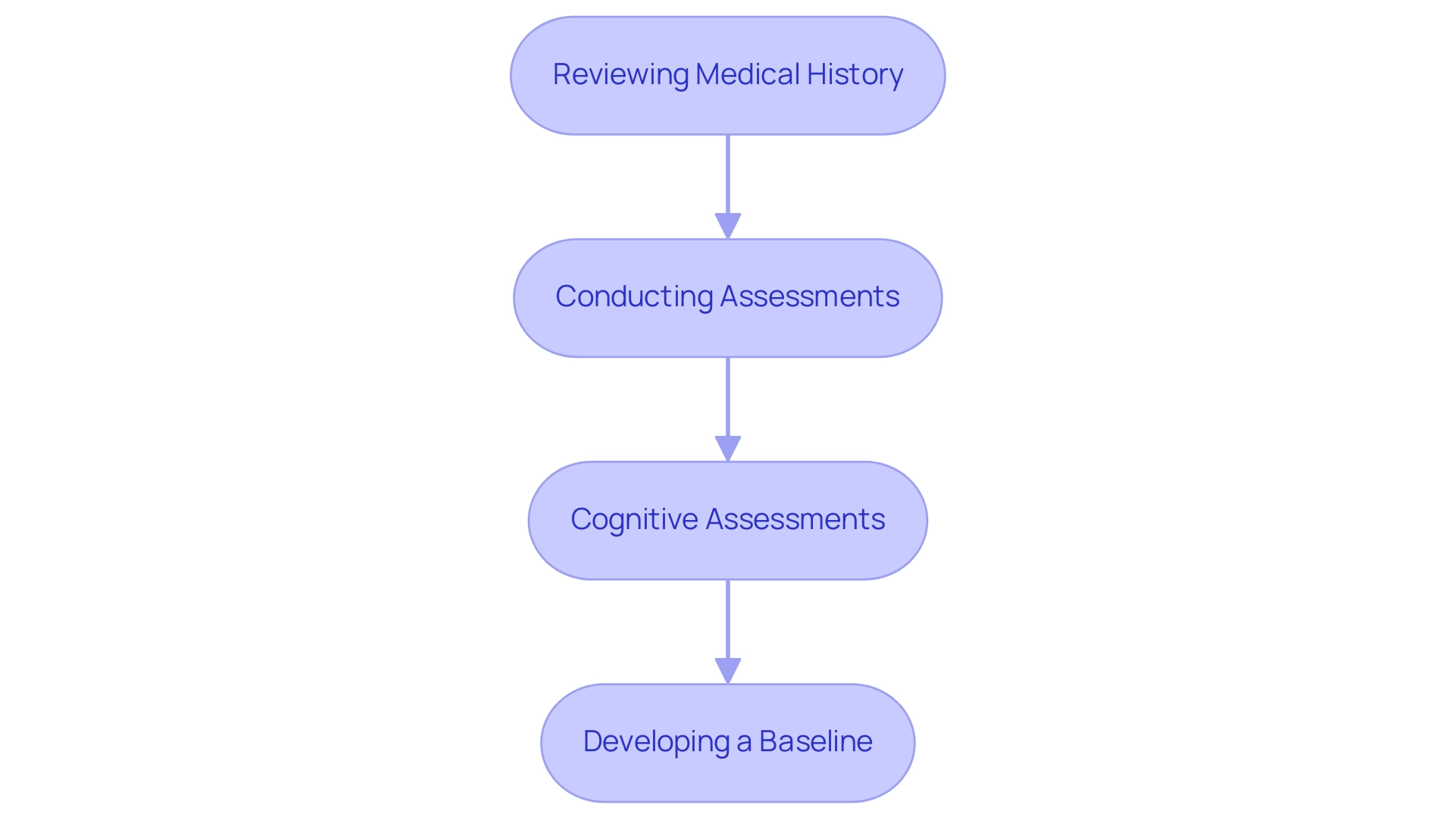
5. Recent Advances and Research in Aphasia Treatment
Recent advancements in the management of language disorders have produced valuable insights into effective aphasia treatment methodologies. Intensive counseling sessions in aphasia treatment have demonstrated potential, with studies suggesting that greater frequency of care correlates with enhanced patient outcomes. For example, a study carried out by Webster and Whitworth in 2012 emphasized the beneficial effect of focused verb treatment in individuals with language impairment.
Additionally, the role of neuroplasticity has garnered attention, revealing the brain's remarkable capacity to adapt and reorganize itself in response to aphasia treatment interventions, which is crucial for enhancing recovery and rehabilitation efforts. Furthermore, innovative technologies, including virtual reality and teletherapy, have emerged as transformative tools in aphasia treatment, significantly improving accessibility to speech therapy. As highlighted by Swathi Kiran in the Technology-Based Treatment Options for Communication Disorders series, these advancements emphasize the potential of technology to transform aphasia treatment for individuals experiencing language difficulties.
The Living With Aphasia Framework for Outcome Measurement (A-FROM) and the Life Participation Approach to Aphasia (LPAA) further emphasize the necessity of personalized care in aphasia treatment, focusing on the functional impact of communication disorders and enhancing daily participation. Recent statistics indicate that
8% of individuals with aphasia (PWA) experienced deterioration in one area while showing improvement in another, highlighting the complexity of intervention outcomes. This statistic underscores the importance of tailoring aphasia treatment to meet individual needs.
Moreover, corrections made to the original article regarding missing confidence intervals and effect size, with an updated effect size of 0.64, enhance the credibility of these findings. These emerging insights emphasize the importance of ongoing research aimed at refining therapeutic approaches, particularly in the context of aphasia treatment, and ultimately improving patient care.
Conclusion
Aphasia treatment encompasses a wide range of techniques designed to empower individuals facing communication challenges. Key strategies include:
- Traditional speech therapy
- Cognitive rehabilitation
- Group therapy
- Technology-assisted methods
- Family involvement
Each strategy is tailored to meet the unique needs of patients. Recent research highlights the effectiveness of intensive therapy and multimodal approaches, demonstrating the potential for significant improvements in language performance when treatments are personalized and administered promptly.
The role of speech-language pathologists is central to the success of aphasia rehabilitation. They not only assess and diagnose language impairments but also develop individualized treatment plans grounded in evidence-based practices. Their collaboration with families enhances the therapeutic process, creating a supportive environment that fosters recovery. The assessment phase is crucial as it lays the groundwork for effective treatment, ensuring that all relevant factors are considered in the design of therapy.
As ongoing research continues to unveil new insights and advancements, the landscape of aphasia treatment is evolving. The integration of innovative technologies and intensive therapy protocols is reshaping how care is delivered, emphasizing the importance of a tailored approach that addresses the complexities of each patient's condition. Ultimately, the commitment to personalized, evidence-based treatment strategies is vital for improving communication abilities and enhancing the quality of life for those affected by aphasia.
